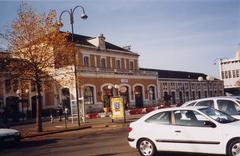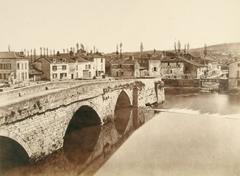
Citadelle Gallo-Romaine De Vésone: Visiting Hours, Tickets, and Historical Significance in Périgueux
Date: 04/07/2025
Introduction
In the heart of Périgueux, France, the Citadelle Gallo-Romaine de Vésone stands as a monumental testament to the region’s Roman and Celtic past. First established as Vesunna, the capital of the Petrocorii tribe, the city flourished under Roman rule from the 1st century BCE, evolving into a significant urban center with a grand forum, amphitheater, and the iconic Tour de Vésone—a temple dedicated to the goddess Vesunna. By the late 3rd century CE, facing political instability, the city protected itself with massive fortifications, exemplifying late Roman military architecture and the adaptive reuse of earlier monuments. Today, the archaeological remains are preserved within Parc de Vésone and interpreted at the Vesunna Gallo-Roman Museum, offering visitors an immersive journey into the daily life and enduring legacy of ancient Vesunna (Via Antiqua, Musée Vesunna, POP Patrimoine).
Table of Contents
- Origins and Foundation of Vésone
- Romanization and Urban Development
- Defensive Restructuring in Late Antiquity
- Social and Administrative Life
- Decline, Transformation, and Heritage Protection
- Key Architectural Features
- Archaeological Museum: Vesunna
- Visitor Information
- Practical Travel Tips
- Nearby Attractions
- FAQs
- Conclusion and Call to Action
- References
Origins and Foundation of Vésone
The Citadelle Gallo-Romaine de Vésone traces its roots to the early Roman Empire following the conquest of Gaul. Before Roman occupation, the area was inhabited by the Celtic Pétrocores, noted in Julius Caesar’s accounts (Via Antiqua). With the administrative reorganization of Aquitania under Augustus, Vesunna was established as the capital of the Civitas petrucoriorum, symbolizing both continuity and transformation in the region’s identity.
Strategically located along the Isle River, Vesunna’s urban planning and architecture reflected Roman ideals. By the mid-1st century CE, the city included a forum and amphitheater, marking it as a major center in Roman Aquitania (Via Antiqua).
Romanization and Urban Development
Romanization in Vesunna was rapid and profound. The local Gallic elite embraced Roman customs, participating in civic life and constructing grand residences (domus) with peristyles, painted walls, and mosaics (Via Antiqua). The Tour de Vésone, a cylindrical temple dedicated to the goddess Vesunna, illustrates the blend of local religious traditions with Roman architectural forms.
Defensive Restructuring in Late Antiquity
By the late 3rd century CE, Vesunna faced turmoil, prompting a significant urban contraction and the construction of monumental defensive walls (Waymarking). The new citadel was built using stones from earlier public buildings. Its ramparts, measuring up to 6 meters thick and 9 meters high, were reinforced by 24 towers and three monumental gates, including the well-preserved Mars Gate—an enduring symbol of the city’s resilience (Waymarking).
Social and Administrative Life
Throughout antiquity, Vesunna maintained vibrant civic life led by locally integrated notables. The forum remained the center of political, economic, and religious activity. The process of Romanization was not only imposed but also embraced by local elites, as evidenced by the city’s material culture, which blends Celtic motifs with Roman forms (Via Antiqua).
Decline, Transformation, and Heritage Protection
As the Western Roman Empire weakened, Vesunna experienced contraction and transformation, with fortifications built from the remains of earlier monuments. Despite these challenges, the city continued as the capital of the Pétrocores, demonstrating remarkable resilience (Waymarking). Today, the remains enjoy protected status as Monuments Historiques, ensuring their preservation (POP Patrimoine).
Key Architectural Features
The Enceinte and Towers
The citadel’s oval plan, with walls up to 6 meters thick and reinforced by 24 towers, is a rare example of late Roman military architecture in Gaul. Construction utilized spolia—reused stone and columns from earlier Roman buildings—a testament to both resourcefulness and urgency (POP Patrimoine).
The Mars Gate
Among the original three gates, the Mars Gate stands out for its preservation and architectural detail, flanked by round towers and decorated with pilasters and a Tuscan entablature.
Tour de Vésone
A monumental cylindrical structure over 24 meters high, the Tour de Vésone is believed to be the cella of a temple to the goddess Vesunna. It represents advanced Roman engineering and is one of the best-preserved Gallo-Roman religious monuments in France (Monumentum.fr).
Archaeological Museum: Vesunna
The Vesunna Gallo-Roman Museum is built around a grand Roman domus and offers interactive exhibits, models, and artifacts that contextualize the citadel and its surroundings. Designed by Jean Nouvel, the museum’s glass walls integrate archaeological remains with the surrounding park, providing a unique visitor experience (Journées de l’Archéologie).
Visitor Information
Visiting Hours
- Parc de Vésone: Open daily from 7:30 AM.
- Vesunna Museum:
- October–March: Tue–Fri 9:30–12:30 & 13:30–17:00; Sat–Sun 10:00–12:30 & 14:30–18:00
- April, May, June, September: Tue–Fri 9:30–17:30; Sat–Sun 10:00–12:30 & 14:30–18:00
- July–August: Daily 10:00–19:00
- Closed Mondays and some holidays (Vesunna Museum).
Tickets and Accessibility
- Parc de Vésone: Free access.
- Vesunna Museum: Admission approx. €8 for adults; discounts for students and children; free for children under 18. Tickets available online or at the museum.
- Accessibility: The site and museum are wheelchair accessible, with ramps, tactile exhibits, and audio guides.
Guided Tours and Special Events
Guided tours and workshops are available, particularly during summer and special events like European Archaeology Days. Advance booking is recommended (Journées de l’Archéologie).
Practical Travel Tips
- Getting There: Centrally located in Périgueux, the site is accessible by foot, public transit, and car (with nearby parking).
- Best Time to Visit: Early mornings and weekdays are quieter, especially in summer.
- Amenities: The park offers shaded seating and picnic areas; the museum has accessible restrooms and a shop.
- Weather: Summers can be hot—bring sun protection and water.
Nearby Attractions
- Château Barrière: Medieval fortress built into the Roman ramparts (Guide du Périgord)
- Église Saint-Étienne-de-la-Cité: The city’s first cathedral.
- Jardin des Arènes: Remains of the Roman amphitheater.
- Périgueux Cathedral and Medieval Old Town: Key sites reflecting medieval and Renaissance heritage.
- Périgord Museum of Art and Archaeology: Collections spanning prehistory to the Renaissance.
FAQs
Q: What are the visiting hours for the Citadelle and Vesunna Museum?
A: Parc de Vésone is open daily from 7:30 AM; the Vesunna Museum has varying hours, generally 9:30/10:00 AM to 5:00/6:00 PM, with extended hours in summer. Closed Mondays.
Q: Is there an entrance fee?
A: The park and outdoor ruins are free; museum entry costs approx. €8 for adults, with discounts and free child entry.
Q: Is the site accessible?
A: Yes, both park and museum are wheelchair accessible; guides and adapted materials are available.
Q: Are guided tours available?
A: Yes, especially during the high season and special events. Reserve in advance for group tours.
Q: Can I take photographs?
A: Yes, personal photography is allowed outdoors; some restrictions may apply inside the museum.
Conclusion and Call to Action
The Citadelle Gallo-Romaine de Vésone offers a remarkable window into the ancient world, where Roman urbanism, military ingenuity, and Celtic traditions intertwine to tell the story of Vesunna’s transformation and enduring legacy in Périgueux. Today, its carefully preserved ruins and the innovative Vesunna Museum provide deep insight into the region’s history. Périgueux’s rich blend of Roman and medieval heritage, vibrant market culture, and inviting amenities make it a must-visit destination for history lovers and travelers alike.
Begin planning your journey today—consult the official museum website, download the Audiala app for interactive guides, and follow local tourism channels for the latest updates and events. Immerse yourself in the layers of history at the Citadelle Gallo-Romaine de Vésone and discover the wonders of Périgueux!
References
- Via Antiqua
- Musée Vesunna
- Waymarking
- POP Patrimoine
- Guide du Périgord
- France.fr
- Audiala
- Everything Dordogne
- The Crazy Tourist
- The Geographical Cure
- Journées de l’Archéologie
- Monumentum.fr













